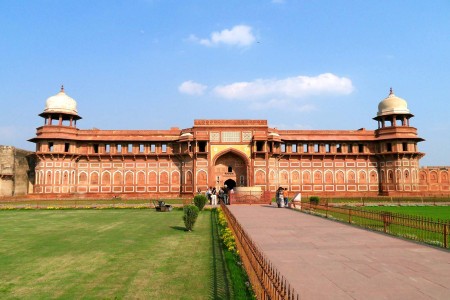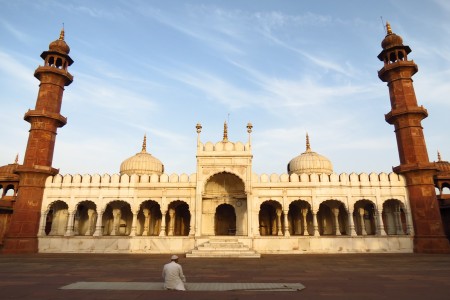Agra
Agra is also known as the Land of palaces. Not just palaces, it also has a lot of intricate and beautiful architecture. Even the tombs are elaborately adorned. Agra is the perfect spot for a tourist and students of Architecture. Even the climate in Agra is very inviting and suitable. The city is well designed, where even the houses show huge detailing in their design. On close inspection, even the interiors of the buildings show the unreal imagination that the architects probably had. Every building, looks like it had been designed to adorn the city, designed artistically from every angle. Even the food speaks greatly about the spicy Indian Cuisine.

Taj Mahal
Taj Mahal is one of the most famous tourist attractions in India and across the world. It’s one of the Seven Wonders of the World. Completed in 1653, The Taj Mahal was built by Mughal Emperor Shah Jahan in memory of his beloved wife Mumtaz Mahal, as a symbol of eternal love. Taj Mahal is built on a red sandstone base, topped by a huge white marble terrace on which rests the dome flanked by four tapering minarets.

Agra Fort
History & Culture Agra fort was commissioned by the great Mughal Emperor Akbar in 1565. During Shah Jahan’s era, the red sandstone fort was reformed into a palace and extensively repaired with marble and pietra dura inlay. Distinguished buildings in the fort are the Pearl Mosque, Jahangir’s Palace, Diwan-e-Am, Diwan-e-Khas (public and private audience halls), Shish Mahal, Musammam Burj and the Khas Mahal. The fort is semi-circular shaped, flattened on the east with a long, nearly straight wall facing the river.

Itmad-ud-Daulah’s Tomb
This Mughal Mausoleum in the city of Agra was built at the command of Noor Jahan (wife of Jahangir) for her father Mirza Ghiyas Bagh, who was honored with the title of Itmad-ud-Daula (pillar of the state). This is where the mausoleum took its name from. The walls of the mausoleum are built in white marble and embedded with semi precious stones. The cenotaphs of both the father and mother of Noor Jahan lay side by side in the tomb.

Fatehpur Sikri
History & Culture Founded by the great Mughal emperor Akbar, in the year 1569, Fatehpur Sikri served as the capital of the Mughal Empire during the years 1571-1585. Named as Fateh (meaning victory) in the beginning, it was later known as Fatehpur Sikri. It was home for the birth of navaratnas (9 jewels). It stands as a representation of the infamous Mughal architecture with unique designs and artworks. The building was made of red stones and Akbar intended to revive the Persian court splendors made by his ancestor Timur, but eventually it came through as the classic Indian embellishments.

Akbar’s Tomb
History & Culture Built solely for the great Mughal emperor, the Akbar Tomb was built in 1605-1613. It covers a good area of 119 acres in the Sikandra. It was Akbar himself who initiated the works in 1600 as per the Tartary tradition. Located in the suburbs, about a kilometer away lies the tomb of Miriam, Akbar’s wife. The southern gate is similar to those of the Taj Mahal with 4 white marble chhatri and also serves as the entrance to the tomb.

Jama Masjid
Religious Built in the 1648s, by Shah Jahan, Jama Masjid stands facing the Agra fort and overlooks the Agra Fort Railway Station in India. It was built by Shah Jahan in dedication to his favorite daughter. In order to create the Agra Fort Railway Station, the octagonal Tripolia Chowk was destroyed. The main entrance is on the eastern side. The prayer chamber is decorated with slender turrets with alternate kiosks. It is said to be the largest dome among the three and also the highest, crowning the sanctuary.

Moti Masjid
Religious Among the holy places in Agra, Moti Masjid holds a special place. Proudly known as the pearl white, it was said to have been built by Shah Jahan for worship for the court members. Its artwork and beauty stamps the rich craftsmanship of India. Built between the years 1648 and 1654, it cost Rs. 1,60,000 to complete the works. It is made of 12 arches facing from the North, East and South. The main entrance is located on the eastern side, and the prayer chamber is ornamented with intricate designs adding glory to it.

Sikandra Fort
The last resting place of Akbar the great, 13 km away from the Agra Fort, the Sikandra fort is one of the preserved monuments in India. Started by Akbar, it was completed by Jahangir, his son which is the foundation for Sikandra Fort Complex. Surrounded by a beautiful lush garden, it is located in the western periphery of the city. The tomb reflects the characteristics of the great emperor with its beautiful and intricate carvings marking a phenomenal beginning to his end.
